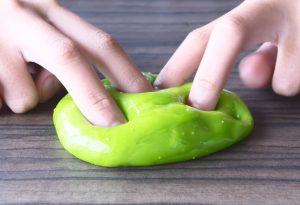In this Article
Your child is at an age when the world around him/her seems exciting and plain old fun. It’s no wonder it’s the best time to introduce your kindergarten kids to the fascinating world and wonders of science. Here are a couple of easy kindergarten science experiments for your kids.
Simple Science Experiments For Preschool Children
These cool kindergarten science experiment ideas can be done indoors and outdoors and will assimilate fine motor and observational skills in kids. Try these out at home and outside too.
1. Sink And Float
Sink and float is a fun science game where you take a sheet of paper and label two columns as sink and float, respectively. You then tell your child to collect a couple of household and simple outdoor objects and try placing them one at a time in a big bowl or pan of water to see whether they sink or float.
The science behind this is that heavy objects sink while light objects float. Your kids will love it.
2. Invisible Drawing
Tell your kid to take a pan of water and mix in a few drops of dishwashing detergent. Get them a cotton swab and encourage them to draw or write their favorite letters on the bathroom window. After a hot bath or steam bath, they’ll notice that the letters or pictures they drew on the glass become visible despite the foggy surroundings.
The science behind this is that dishwashing detergent prevents water molecules from forming on the surface. Amazing!
3. The Egg Game
Give your kid a glass and ask him to pour water till the halfway mark. Now, ask your kid to mix six tablespoons of salt and stir. Again, instruct your kid to gently add water till it the glass is almost full. Tell him/her to place the egg in the water and watch what happens. The egg will float because salt increases the density of the water.
4. The Magnet Game
Ask your kid to gather a few items from around the house and place them near a magnet one by one. The ones that are made from metal or nickel will get pulled in while the others won’t stick to the magnet. It’s a cool way to teach your kid about the magnetic properties of metals.

5. Colour Theory Game
Take three glasses and fill them with water and add food colouring in each. Make sure the colours you add are red, yellow, and blue. Ask your kid to mix the colours and observe how new colours form. The science behind this is that red, yellow, and blue, are primary colours which can be used to create more colour variations.
6. Ice Cups
Ask your kid to take three cups of water and fill them up to the brim. Cover one of them with a lid and tell him to put them all in the freezer. In the morning, remind your kid to take them out from the freezer and check them again. The cup with the lid will have noticeable cracks; the reason being water expands when frozen to cold temperatures, causing the cup to crack.
7. The Balloon Experiment
Inflate a balloon and place it near your kid’s ear. Gently tap it and watch him/her marvel at the outcome. The science lesson in this is that air molecules move and collide with each other, thus increasing sound waves.
8. The Wave Game
Take a bottle and fill 3/4 of it with water and the rest with castor oil. Add food colouring to the mix and ask your kid to turn it upside down or side to side. Colourful waves will travel from one end to the other, thus teaching them that the Earth’s gravitational pull causes waves as it rotates around the sun.
10. The Gravity Game
Take a big watermelon and apple. Make sure you weight them each apart so that your kid realizes which one is heavier. Take them to a tall playground structure and ask him/her to drop both of them at the same time. If done correctly, both the objects will hit the ground at the same time. Your kid may be baffled at this experiment and ask how the heavier object didn’t reach the ground before the lighter one.
The answer is the Earth’s gravity attracts all objects with an equal pull and this pull’s force doesn’t change based on the weights of different objects. Repeat this experiment with bowling balls, ping pong balls, and other objects and watch your kids’ curiosity unfold! Newton would be proud.
11. The Water Lesson
This little game involves three coffee cans, pieces of black construction paper, some tape, moist dirt, sand, and some time. Place the three cans in front of a sunny window on top of a radiation. Tape all the three with black construction paper except make sure that the second one is filled halfway with moist dirt and the third with sand. Ask your kid to make a hypothesis and check back after a while. Your kid will notice that the paper taped to the can filled with dirt will be drenched with moisture while the sandy can will have light traces of moisture, thus proving that soil retains water.
This lesson is also tied to their kindergarten curriculum and introduces them to their water cycle lessons too!
Best Science Experiments For Children
We understand your kid may be entering junior high any time which is why we have covered science experiments for children who are older than kindergarten kids too. Here are a couple of easy science experiments for kids of older age groups-
1. The Shadow Game
Everyday life provides many opportunities for this fun little game. Ask your child to investigate his shadow and guess where the light source comes from. What happens if he changes the shape of the shadow and takes objects like hula hoops and morphs it into different shapes? What happens if you change the direction the hula hoop is facing or if you move to a different spot outdoors or indoors? Explore this game with a lamp as well.

2. Backyard Detectives
Take your kid out on a detective adventure to the backyard or a park. Ask him to explore different species of plants, bugs, insects, and small-sized animal species. Teach them to observe trees and look for signs of animal life there. Have the leaves been eaten or has the soil been burrowed? Ask questions aloud like, ‘I wonder what the ants eat?’ or ‘I wonder how the caterpillar moves’ will teach you kid about the structures of organisms and how they meet their basic needs. Ask your child to wonder about which animals take shelter where and when they come out. Document these changes and capture outdoor moments on camera every season to make memories and have fun exploring hands-on learning.
3. Playground Science
Take your kid to the playground and ask them to balance themselves on swings or play structures. Ask them to think about what they are doing and how long they are able to maintain balance based on different postures. Tell them to think about what happens when they push harder on the swing and why it happens. Playing on the swings will teach your kids about equal and opposite forces.
4. Weather And Structure Games
When taking your kid on car rides or bus trips, ask him to describe the shapes and number of clouds, whether the sun is visible or not or where light comes from, the differences between manmade structures, and describing what the weather is like. These observations will model their senses and enhance their understanding of their surroundings. Ask your child to reason why the moon follows them at the night and explain to them why that appears to be so but is not.
5. Building Blocks
Take your child to construction sites or places with bricks and stones. Ask him to look closely and notice whether the stone has multiple colours or how they differ in shape and texture. Explain to him how buildings are made and how the materials look and differ in their foundations. What kind of challenges do construction workers face during building constructions and why are the rooftops of houses slanted? These experiences will build your child’s observation skills and awareness of their environments.
6. Kitchen Experiments
The kitchen is a wonderful avenue for developing a sense of measuring and observing how changes take place (foundations of chemistry). Children of this age are curious and want to help out in the kitchen. Let your child do that by encouraging him/her to mix ingredients, play with recipes, and watch how changes occur when two ingredients mix and heat up on the pan. Make scrambled eggs and pancakes in front of your child and allow them to observe how the fire changes the shape and colour of the yolk and encourage him/her to describe what he/she is seeing.
7. Coloured Flowers
Capillary action is when water flows through small spaces without the help of gravitational pull or external opposing forces. This phenomenon is due to the high surface tension of fluids and it explains how a sponge draws water into it or how hair strands stay wet after a bath even if gravity acts on them. A fun experiment to demonstrate this is to take a bunch of white flowers, trim with angled cuts and place them in a cup of lukewarm water. Add a couple drops of food dye and colouring and let the flowers sit for a few hours, until they begin to change colours. Your kids will be left mind-blown with this experiment.
8. Homemade Slime
Slime ranks at the top of childhood memories and who doesn’t have fond memories of watching Ghost Busters as kids? For this cool little trick, take a 1/4 cup of water, 1/4 cup of white school glue, and add a few drops of food colouring to the mix. Add borax solution to the glue and water and mix. Continue kneading till it results in a texture you like and remove the slime from your bowl or cup and have fun.

9. Paper Airplanes
Teach your kids a little bit about physics and origami by making a paper airplane. Let it fly and bend its corners to demonstrate how the plane changes its flight path.
10. Mentos Fun
This experiment is a little explosive in nature so make sure to stand back when watching it go. For this you need a can of diet coke and a mentos pack. Drop in a mentos (or two) in the can of diet coke can and watch it explode! Older kids absolutely love it!
Kids love quenching their curiosity and exploring the marvels of science. At these budding ages, let them explore, have fun, and try out these science experiments and activities for kids at home and outside while you’re at it!
Your kid will definitely think you’re cool and creative and give you props for your taste of adventure with these easy but fun indoor and outdoor science experiments!









